So, from I can tell from the answers I received to my previous questions, if I want to lower the output current from a battery, I could put a resistor in series with my circuit.
But wouldn't that only lower the current by some amount? If the battery output was lower than expected, it would be reduced farther by the resistor. And a greater than expected output would still be higher than the target current?
Another possibility is that I am hopelessly confused by all this, and should go find a nice book on EE.
edit:
I should have said that the circuit I am trying to make, requires a fairly steady current flow, with a maximum current and a minimum current. (The minimum current is not super important, but it can't exceed the maximum current.)
edit: I should probably give a few more details. My coil/s should have 0.97232Ω of resistance, should use about 7.263 meters of wire.
edit:
Could I use a current mirror?

With the reference current set to what I need my battery output to be?